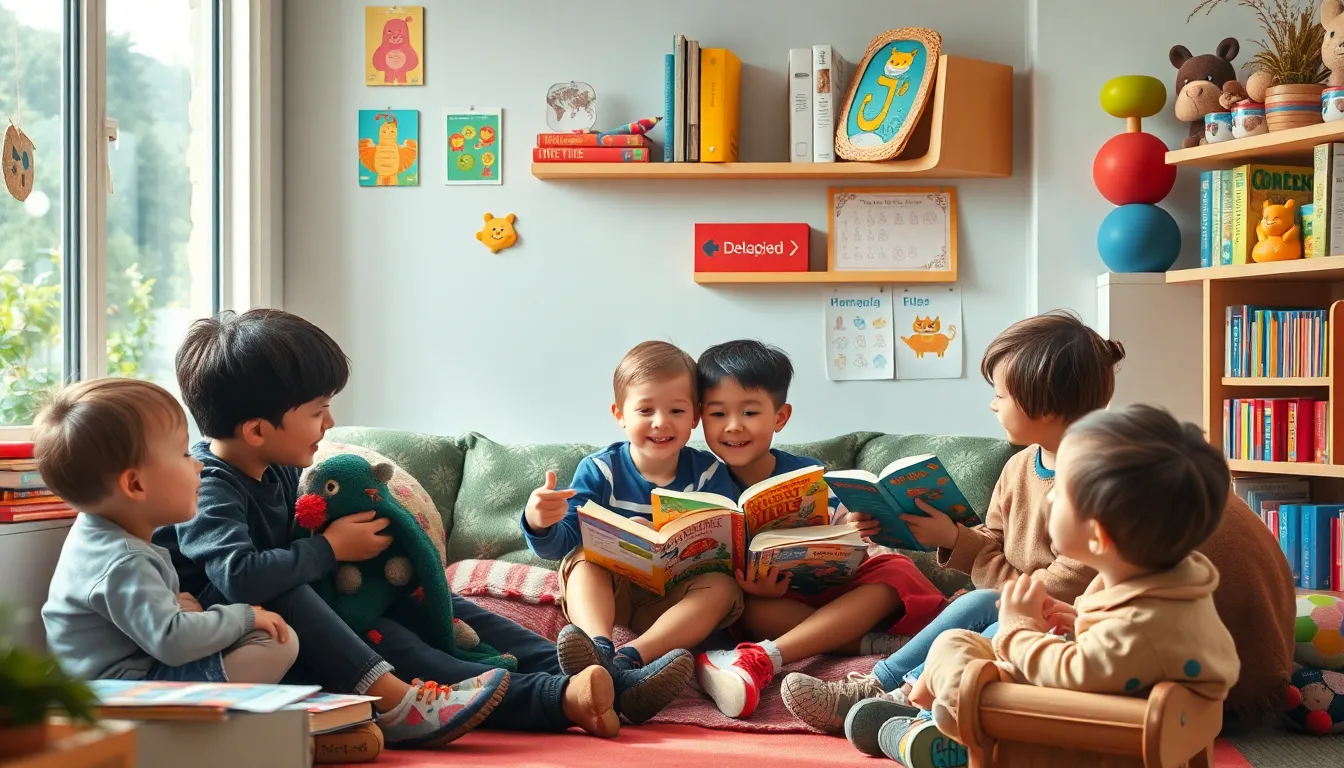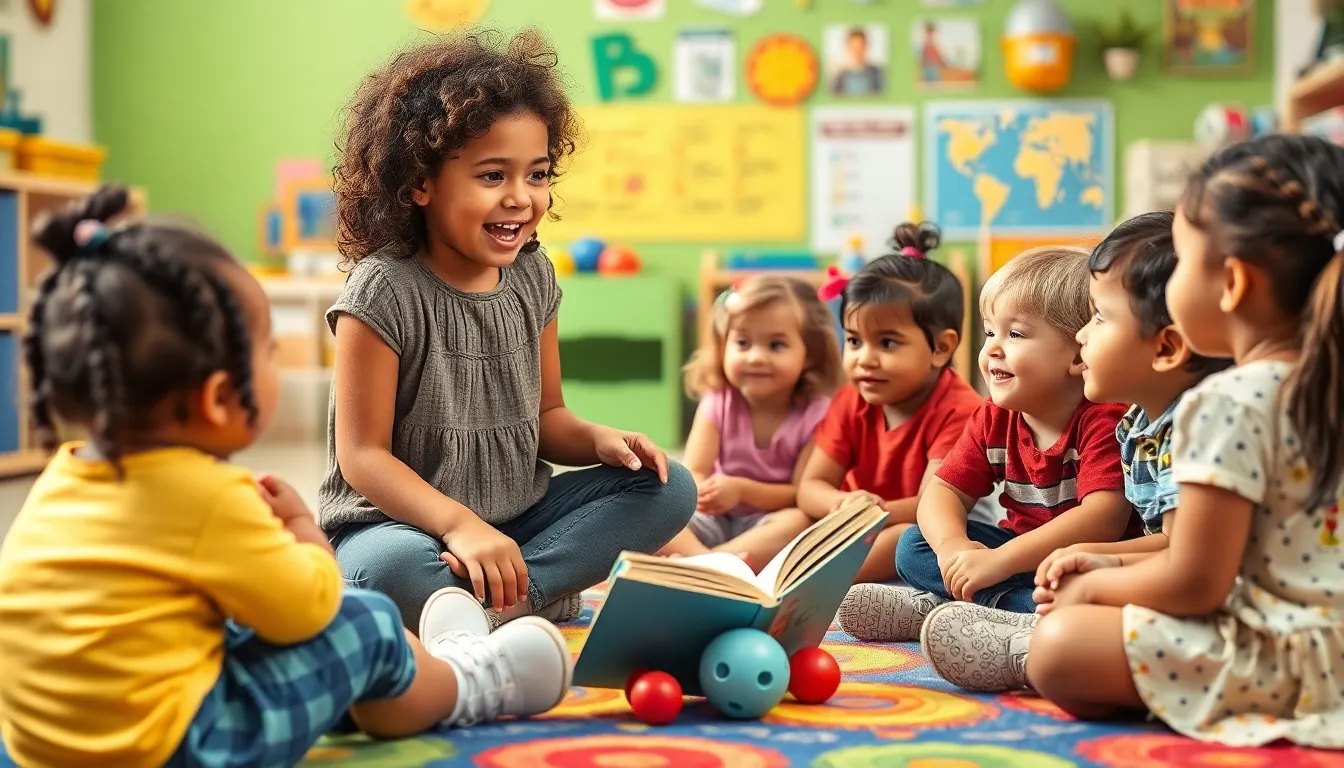Table of Contents
ToggleLanguage and literacy development isn’t just about memorizing the alphabet or stringing words together. It’s the magical journey where toddlers transform into little word wizards, wielding their newfound skills like a superhero with a cape. Imagine the joy of watching a child go from babbling to storytelling, captivating their audience with tales of dragons and daring adventures.
Overview of Language and Literacy Development
Language and literacy development occurs as children grow, reflecting a complex journey that fosters communication skills beyond basic alphabet recognition. This transformation engages their creativity and nurtures storytelling abilities.
Importance of Early Development
Early language development significantly influences cognitive skills. It forms a strong foundation for academic success. Studies show that children exposed to rich language environments demonstrate better literacy outcomes. Enhanced vocabulary directly correlates with reading proficiency. Moreover, early interactions with caregivers foster essential communication skills. Engaging conversations provide context for new words, promoting understanding and retention. The quality of language exposure shapes children’s abilities to express themselves and comprehend others. Therefore, nurturing language-rich experiences contributes to overall cognitive and social development.
Stages of Language Acquisition
Language acquisition progresses through distinct stages, each marked by specific milestones. Infants start by cooing and producing simple sounds. Babbling follows, as children experiment with phonetics. Next, toddlers begin using single words, often linking them to familiar objects or people. Vocabulary expansion occurs rapidly, typically around ages 2 to 3. By age 4, children start combining words into simple phrases, showcasing basic grammar understanding. Advanced structures develop as they approach age 5, enabling them to construct more complex sentences. Children actively build language skills through play and interaction, illustrating their growing comprehension and use of language.
Factors Influencing Language and Literacy Development

Language and literacy development is shaped by various factors that significantly impact children’s growth. Understanding these influences is essential for fostering effective learning environments.
Environmental Influences
Rich language environments play a pivotal role in children’s language and literacy development. Children exposed to diverse vocabulary speak more proficiently and demonstrate higher reading skills. Interactive settings promote conversation and storytelling, enhancing communication abilities. Factors such as socio-economic status also affect access to resources like books and educational materials. Engaging experiences, including outings or cultural activities, broaden a child’s linguistic exposure. Creating an atmosphere rich in spoken and written language encourages curiosity and skill development.
Parental Involvement
Engaged parents positively influence language and literacy growth. Regular conversations with children foster vocabulary acquisition and comprehension. Reading together establishes routine and enhances listening skills. Parents who model positive language use support their child’s ability to express thoughts clearly. Encouragement during play or storytelling boosts creativity and confidence. Active participation in educational activities demonstrates the importance of language and literacy, reinforcing the value of communication. Research shows that children with involved parents achieve better literacy outcomes, forming a critical link between family involvement and academic success.
Strategies for Promoting Language and Literacy Development
Promoting language and literacy development requires intentional strategies that engage children actively. These strategies enhance vocabulary and comprehension skills effectively.
Interactive Reading Techniques
Interactive reading techniques foster engagement and comprehension during storytime. Parents can ask open-ended questions about the plot, encouraging children to think critically about the story. Incorporating character voices makes narratives more relatable and exciting, keeping children interested. Pausing to discuss illustrations helps develop observational skills and vocabulary. Integrating repetition of favorite phrases reinforces memory retention, enhancing language acquisition. Using props or puppets related to the story encourages imaginative play, further linking literacy to enjoyable experiences.
Educational Tools and Resources
Educational tools serve as essential resources in promoting language skills. Flashcards can introduce new vocabulary in a fun, interactive way. Digital applications often provide engaging activities that reinforce literacy concepts and track progress over time. Audiobooks offer an opportunity for exposure to different genres and narrations, enhancing auditory skills. Group activities, such as storytelling sessions, stimulate peer interaction and communication. Furthermore, online platforms provide countless games designed to support phonetic awareness and reading comprehension. Each tool contributes to a comprehensive approach to language and literacy development, enriching children’s overall learning experience.
Challenges in Language and Literacy Development
Language and literacy development presents several challenges that can impact children’s growth and learning. Understanding these hurdles enables caregivers and educators to implement effective strategies.
Learning Disabilities
Learning disabilities significantly hinder language and literacy development. Children with dyslexia, for instance, struggle with reading and phonetic awareness, making it difficult to acquire essential skills. Auditory processing disorders also impair the ability to understand spoken language, affecting comprehension and vocabulary growth. Observing children’s responses to language activities helps identify potential issues early on, allowing for timely interventions. Specialized teaching methods and individualized support provide pathways for children to succeed despite their challenges.
Socioeconomic Factors
Socioeconomic factors critically influence access to resources for language and literacy development. Families with limited financial means often lack access to books, educational materials, and enriching experiences. Exposure to varied vocabulary is diminished in environments where educational resources are scarce. Communities with fewer libraries and literacy programs present additional obstacles, restricting opportunities for improvement. Parental education levels can also affect children’s language skills, as parents may not feel equipped to facilitate learning. Addressing these disparities involves creating supportive programs that improve literacy access and enhance language experiences for all children.
Language and literacy development in early childhood is a vital journey that shapes a child’s future. By fostering rich language environments and encouraging active participation, caregivers can significantly enhance children’s communication skills. Engaging interactions and diverse vocabulary exposure play crucial roles in this transformative process.
Addressing challenges such as learning disabilities and socioeconomic barriers is essential for ensuring all children have access to the resources they need. With intentional strategies and supportive programs, families can help their children thrive in language and literacy, paving the way for lifelong learning and success.




